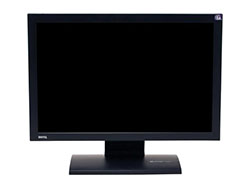Pre-AM2 Mid-Range Buyers' Guide, May 2006
by Jarred Walton on May 9, 2006 6:30 AM EST- Posted in
- Guides
Display Recommendations
We used about one fourth of the total budget on the motherboard and processor recommendations, and we're willing to use another fourth of the budget on a good quality display. I've said it in the past: I'm done with CRT recommendations. It's not that LCDs are perfect, but CRTs pretty much target the budget market exclusively these days, not mention their size disadvantage. We wish it was possible to get a 1920x1200 LCD with a 100 Hz refresh rate, for example, but unfortunately such a resolution is not part of the DVI spec.I also encourage people to overspend on displays if at all possible; a good display can easily outlast the rest of your system, and you're going to be staring at it every day that you use your computer. We've recommended 19 inch LCDs in the past for the midrange sector, but prices are at the point where we can now fit a 20 inch widescreen display into the $1500 midrange budget. Naturally, if you don't want to spend $325, you can skip out on the 20 inch widescreen displays, but we feel the extra $75 is money well spent.
 |
| Click to enlarge |
Display Recommendation: BenQ 20 inch 8ms Widescreen LCD FP202W
Price: $325 shipped (Retail)
BenQ's latest LCD offering has a great price, and it's a reasonable quality display as well. 16.7 million colors (no dithering), DVI and VGA connections, 8ms response times (gray-to-gray/GTG), and a native 1680x1050 resolution. You get all of that for a price of $325 - and Newegg even has a $40 mail-in rebate if you hurry. There's no pivot mode (does anyone actually use portrait mode with widescreen displays?), and a slightly more important negative point is that there's no height adjustment on the stand. The display also feels a bit flimsy, but we would still take it over a sturdier display that costs $100 more.
 |
| Click to enlarge |
Display Alternative: Acer 24 inch 6ms Widescreen LCD AL2416Wd
Price: $735 shipped (Retail)
This is the one alternative that we're explicitly listing. A 20 inch widescreen display is nice, but a 24 inch widescreen display is better! 6ms GTG response times, 16.7 million colors, and a native 1920x1200 resolution. It doesn't get much better than this, at least in the world of the LCDs. In order to keep the price down, Acer doesn't have as many options as some of the other 24 inch displays, but you probably won't miss most of the features. Integrated flash memory reader? Component inputs? The Dell 2405FPW has those, but it also costs more money - even if you can find it on sale. Subjectively, some people will prefer the look and features of the 2405FPW, but it's hard to argue with an extra couple hundred dollars in your pocket.
If you're looking for cheaper display options, check out the 19 inch standard aspect ratio LCDs. The Acer AL1951B ($257), BenQ FP93GX, and BenQ FP91G+ ($220) are some of our top picks, and all three have the requisite DVI connection. Of those, picking a "best" LCD is a matter of compromises. If you're after lower response times, the BenQ "2ms" FP93GX should deliver, though image quality may be compromised in the pursuit of response times on such panels.
For example, the Acer says it has 16.7 million colors while the BenQ displays only list 16.2 million colors with dithering. Dithering isn't the end of the world, but it can affect image quality, so if you do any form of image editing you might want a better display. Whether or not you can see the dithering depends on the individual, the display, as well as how the monitor is being used. Try looking at some color charts showing all 256 shades of red, green, and blue, and see if you can spot the transitions. Using those charts on several 8-bit LCDs, only the green clearly shows individual color transitions, and the 6-bit panel looked about the same.
| Display Alternatives | |
| BenQ 19 inch 2ms FP93GX | 260 |
| Acer 19 inch 6ms AL1951B | 257 |
| BenQ 19 inch 8ms FP91G+ | 210 |










56 Comments
View All Comments
ZJB298 - Wednesday, May 17, 2006 - link
K, so I'm a huge newb, but what's the point of getting or switching to X16 over X8 if there is no performance impact? Is there likely to be more of a performance impact for a gamer or a higher-end graphics card than for a normal user?Basically, is it worth it for me to go searching for another, more expensive motherboard with X16 slots over X8 slots?
JarredWalton - Saturday, May 20, 2006 - link
In my opinion, NO! Dual X16 is just a lot of marketing hype. The board that sport it might benchmark faster at times (by 5% or so), but 5% can be had through BIOS optimizations.Crassus - Tuesday, May 9, 2006 - link
Thanks for a new Buyer's Guide. I wondered when the next one would come for quite some time. It maybe not necessary to bring them as often as when they started, but right now I think they're spaced a wee bit too far apart.It's always a very helpful read and I use it not only as a recommendation of what to buy, but also as an indication of where the industry stands at this time, i.e. what the standard is for any given component. Keep up the good work and (maybe) update them a little more often again.
sabrewulf - Tuesday, May 9, 2006 - link
"Plenty of people are still running old socket 478, 462, and 754 systems, and they're perfectly happy with the level of performance and they have. The latest and greatest computer games almost certainly wouldn't run on those older systems without drastically reducing the graphics quality"754 + PCI-E = perfectly capable of running with maximum eye-candy.
LoneWolf15 - Tuesday, May 9, 2006 - link
And the percentage of Socket 754 mainboards with PCI-E is?Socket 754 performance is decent, but it's truly a dead-end. For hard-core gamers, I'd urge them to get out while they can sell their parts for reasonable cost, much like I'd have said to Socket 423 owners when the P4 switched to 478.
JarredWalton - Tuesday, May 9, 2006 - link
Notice the "OLD" socket 754 part? Obviously, newer 754 PCIe boards are okay. LOL I still do a ton of work on my 754 + 6800GT system, though.sabrewulf - Friday, May 12, 2006 - link
Sorry I guess I didn't notice that word. I'm mostly just speaking up for people like my brother who last year wanted to upgrade his graphics card, but already has a 2.4 ghz 754 chip and couldn't afford a new video card AND an equivalent 939 CPU at the same time, so he got a cheap solid 754 PCI-E board instead. Works great for him, and with AM2 right around the corner, it looks like an even smarter purchase since he can pretty much skip 939 altogether.LoneWolf15 - Tuesday, May 9, 2006 - link
The thought of Socket AM2 didn't excite me, but not just because of the lack of performance. So I think this Upgrade Guide makes a lot of sense (well, at least if you don't need to do a mainboard upgrade at present time).Just the thought of having to completely reload Windows XP was enough to cause me (a month ago) to decide it was better to upgrade to 2GB of DDR and go from a Winchester 3000+ to an Athlon 64 X2 3800+, with no mainboard swap required. My MSI Neo 4 Platinum has been a good board. I plan on getting one year more at the very least out of it before I consider the new platform. I'm sure AM2 is the best option for anyone who still has an Athlon XP (unless they don't wish to save by not swapping out RAM) and that waiting for new Intel hardware is the best solution for anyone who currently has a Socket 478 system or earlier, but now that I have a system board I'm completely happy with, it's really hard to justify an upgrade that would require me to gut the OS...I no longer have that kind of time on a regular basis.
APKasten - Tuesday, May 9, 2006 - link
I find it really hard to believe that 1GB of PC3200, even at low latencies, is worth almost $200. I can get 2 GB at higher latency (4-4-4-7) for about $150! Is the performance boost really worth that much money for just 1 GB? I was always under the impression that more RAM was better than having extra low latency RAM.I took AnandTech's recommendation to get the OCZ EL 512MB (2x256MB) Kit (2.5-3-2-6?) a few years ago. I replaced that with a GeIL 1 GB (2x512MB) kit at 4-4-4-7 last year and I have since had much better performance from my system. That was the only thing I changed on my box. So I guess my real question is, wouldn't 2 GB at higher latencies be better than 1 GB at lower latencies, bang-for-buck-wise?
APKasten - Tuesday, May 9, 2006 - link
Holy crap. Nevermind...I just realized that it was a 2GB kit you were talking about in the article.Sorry. *rolls eyes*